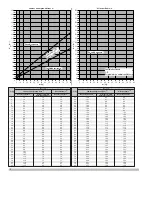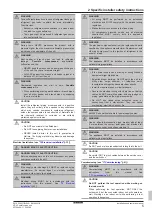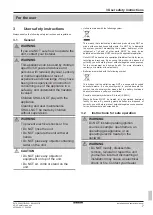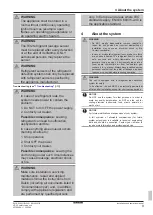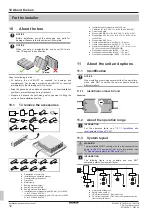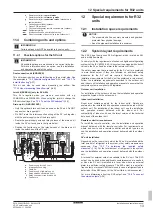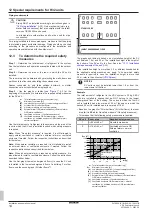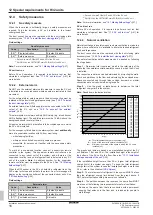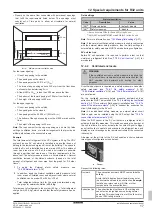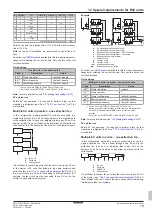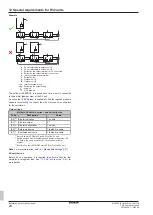
2 Specific installer safety instructions
Installation and operation manual
5
SV1ASV4~8A14AJV1B
VRV 5 safety valve unit
4P709466-1 – 2023.09
WARNING
Take sufficient precautions in case of refrigerant leakage. If
refrigerant gas leaks, ventilate the area immediately.
Possible risks:
▪ Excessive refrigerant concentrations in a closed room
can lead to oxygen deficiency.
▪ Toxic gas might be produced if refrigerant gas comes
into contact with fire.
WARNING
During tests, NEVER pressurise the product with a
pressure higher than the maximum allowable pressure (as
indicated on the nameplate of the unit).
WARNING
Bent header or branch pipes can lead to refrigerant
leakage.
Possible
consequence:
asphyxiation,
suffocation and fire.
▪ NEVER bend the branch and header pipes sticking out
of the unit. They have to remain straight.
▪ ALWAYS support the branch and header pipes at a
distance of 1 m from the unit.
WARNING
Overheated insulation can start to burn.
Possible
consequence:
fire.
▪ When performing brazing work header or branch pipes,
cool all other header and branch pipes by wrapping
them in wet cloths.
CAUTION
Install the refrigerant piping or components in a position
where they are unlikely to be exposed to any substance
which may corrode components containing refrigerant,
unless the components are constructed of materials that
are inherently resistant to corrosion or are suitably
protected against corrosion.
CAUTION
▪ Do NOT use mineral oil on flared part.
▪ Do NOT reuse piping from previous installations.
▪ NEVER install a drier to this unit to guarantee its
lifetime. The drying material may dissolve and damage
the system.
DANGER: RISK OF ELECTROCUTION
DANGER: RISK OF ELECTROCUTION
Before performing work on the unit, disconnect any power
source connected to the unit.
WARNING
If the supply cord is damaged, it MUST be replaced by the
manufacturer, its service agent or similarly qualified
persons in order to avoid a hazard.
WARNING
Electrical wiring MUST be in accordance with the
instructions from this manual. See
33].
WARNING
▪ All wiring MUST be performed by an authorised
electrician and MUST comply with the national wiring
regulation.
▪ Make electrical connections to the fixed wiring.
▪ All components procured on-site and all electrical
construction MUST comply with the applicable
legislation.
WARNING
The electrical components shall only be replaced with parts
specified by the appliance manufacturer. Replacement with
other parts may result in the ignition of refrigerant in the
event of a leak.
WARNING
The appliance MUST be installed in accordance with
national wiring regulations.
WARNING
▪ If the power supply has a missing or wrong N-phase,
equipment might break down.
▪ Establish proper earthing. Do NOT earth the unit to a
utility pipe, surge absorber, or telephone earth.
Incomplete earthing may cause electrical shocks.
▪ Install the required fuses or circuit breakers.
▪ Secure the electrical wiring with cable ties so that the
cables do NOT come into contact with sharp edges or
piping, particularly on the high-pressure side.
▪ Do NOT use taped wires, extension cords, or
connections from a star system. They can cause
overheating, electrical shocks or fire.
WARNING
ALWAYS use multicore cable for power supply cables.
WARNING
Use an all-pole disconnection type breaker with at least
3 mm between the contact point gaps that provides full
disconnection under overvoltage category III.
WARNING
The appliance MUST be installed in accordance with
national wiring regulations.
CAUTION
Do NOT push or place redundant cable length into the unit.
CAUTION
Be careful NOT to pinch cables between the service cover
and the switch box.
Commissioning (see
41])
WARNING
Commissioning MUST be in accordance with the
instructions
from
this
manual.
See
41].
CAUTION
Do NOT perform the test operation while working on
the indoor units.
When performing the test operation, NOT ONLY the
outdoor unit, but the connected indoor unit will operate as
well. Working on an indoor unit while performing a test
operation is dangerous.


